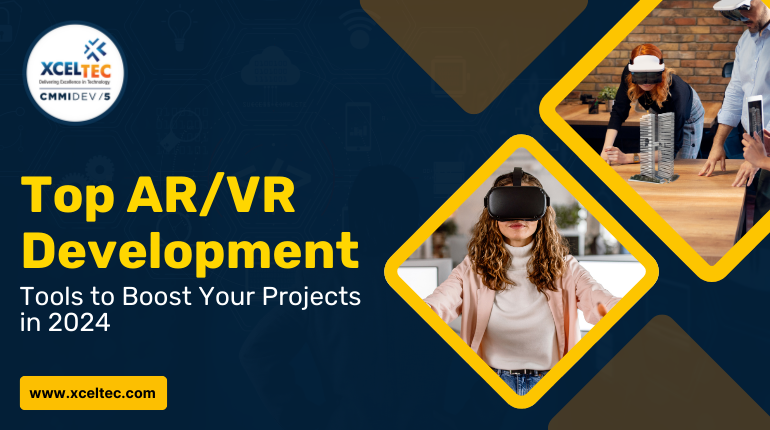The future is immersive. As we step into 2024, the fields of augmented reality (AR) and virtual reality (VR) are shifting how we interact with technology and the world around us. Whether you’re a real developer or just taking a chance in this exciting field, the right tools can make all the difference in bringing your creative visions to life. Here’s a look at some of the top AR and VR development tools that will increase your projects this year.
1. Unity: The Powerhouse of Immersive Experiences
Unity is a great tool for creating impressive 3D content. It works well for both AR and VR development, making it a favorite among developers. Unity offers a wide range of assets and tutorials, which means even beginners can create exciting experiences. Its ability to work on multiple platforms ensures that your projects can reach a large audience.
- Why Use Unity?: User-friendly interface, extensive community support, and powerful tools for 2D, 3D, AR, and VR development.
2. Unreal Engine: Next-Level Realism
If you need top-quality graphics and just a few settings, Unreal Engine is a great choice. It’s well-known for creating games with amazing images and is also excellent for VR and AR. Unreal Engine offers real-time execution and a visual scripting system, which lets you quickly create detailed projects without needing a lot of programming skills.
- Key Features: real-time rendering, clearly flexible visuals, and a node-based scripting system.
3. Vuforia: Augmented Reality Simplified
For those focusing on augmented reality, Vuforia offers a robust and accessible platform. It’s particularly effective for creating AR applications that rely on image approval and object tracking. Vuforia’s SDK integrates smoothly with Unity, allowing developers to create complex AR experiences without a steep learning curve.
- Benefits: ease of use, excellent image recognition, and support for various AR devices.
4. ARKit and ARCore: Mobile AR Leaders
Apple’s ARKit and Google’s ARCore are at the forefront of mobile AR development. These tools leverage the advanced hardware and software capabilities of modern smartphones to create seamless and immersive AR experiences. ARKit offers outstanding integration with iOS devices, while ARCore brings similar capabilities to Android, making them essential for mobile AR projects.
- Highlights: advanced motion tracking, environment understanding, and light estimation.
5. Blender: The Free and Open-Source 3D Creator
The Blender program is a free, powerful tool for creating 3D designs, ideal for developers on a budget. It supports modeling, sculpting, animation, and rendering. For AR and VR, Blender’s features make it easy to create detailed 3D models and environments that you can import into Unity or Unreal Engine.
- Why choose Blender? It’s free, open-source, and offers a careful set of tools for 3D creation.
6. Microsoft HoloLens: Cutting-Edge Mixed Reality
For developers interested in mixed reality, Microsoft’s HoloLens offers a glimpse into the future. This tool combines the physical and digital worlds, enabling the creation of holographic experiences that are both interactive and immersive. HoloLens development leverages Unity, making it easier to transition from other 3D or VR projects.
- Advantages: integration with Unity, advanced holographic processing, and a growing ecosystem of applications.
7. Oculus SDK: Immersive VR at Your Fingertips
Oculus has been a developer in the VR space, and its SDK provides a thorough suite of tools for developing VR applications. With support for both Oculus Rift and Quest, the Oculus SDK helps you create high-quality, immersive experiences that can transport users to entirely new worlds.
- Notable Features: VR motion controls, spatial audio, and extensive documentation and support.
8. ARFoundation: Unified AR Development
If you’re developing for both iOS and Android, AR Foundation provides a single framework. It lets you create AR apps that work with both ARKit and ARCore without needing separate workflows. This tool saves time and effort while ensuring a consistent experience on all devices.
- Perks: cross-platform support, streamlined development process, and integration with Unity.
Conclusion
As AR and VR technologies continue to advance, the tools available to developers are becoming more powerful and available. Whether you’re looking to create a simple AR app or a complex VR simulation, the right development tool can make all the difference. For an AR/VR development company like Xceltec, using AR Foundation provides a streamlined approach for cross-platform AR development.
By leveraging these tools, you can stay at the forefront of the involved technology wave in 2024, creating engaging and innovative experiences that captivate users and pushing the limits of what’s possible.
Get in touch with us for more!
Contact us at: +91 987 979 9459 | +1-980 428 9909
Email us at:- sales@xceltec.com
Visit our website: https://www.xceltec.com/



 :
:









